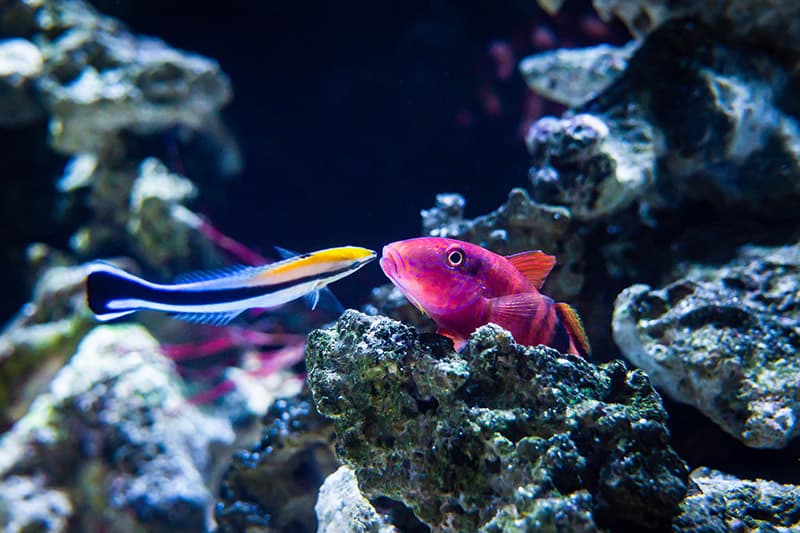| Guide to Cleaner Wrasses | Learn More About Each Wrasse |
|---|---|
To Learn about the concerns of keeping Cleaner Wrasses in home marine aquariums, and the effects of removing them from their natural habitats, see: | |
- For more information on keeping marine fish see: Guide to a Happy, Healthy Marine Aquarium
Blackspot Cleaner Wrasse (Labroides pectoralis)
This video is entitled “Hawaii Cleaner Wrasse,” however these truly are the Blackspot Cleaner. These are known to hybridize with the Hawaiian Cleaner wrasse which has a more intense coloring (yellow head, dark line down the middle, turning very dark 1/2 way with blue and purple edged fins). The Blackspot Cleaner Wrasse is hard to care for long term in captivity because they are obligate fish cleaners. In a huge aquarium of hundreds of gallons with lots of client fish, they may live a little longer. Choose a Bluestreak Cleaner Wrasse (not to cure an outbreak of parasites) but as a pet, since they will adapt to eating aquarium foods like mysis, etc. Even then, they need a lot of clients so they don’t pester the snot out of only a few fish!
Labroides Species
The well known Bluestreak or Common Cleaner Wrasse, L. dimidiatusis, is only one of five described species of cleaner wrasse in the genera Labroides. These five species are:
- Bicolor Cleaner Wrasse Labroides bicolor
- Blackspot Cleaner Wrasse Labroides pectoralis
- Bluestreak Cleaner Wrasse Labroides dimidiatus
- Hawaiian Cleaner Wrasse Labroides phthirophagus
- Redlip Cleaner Wrasse Labroides rubrolabiatus
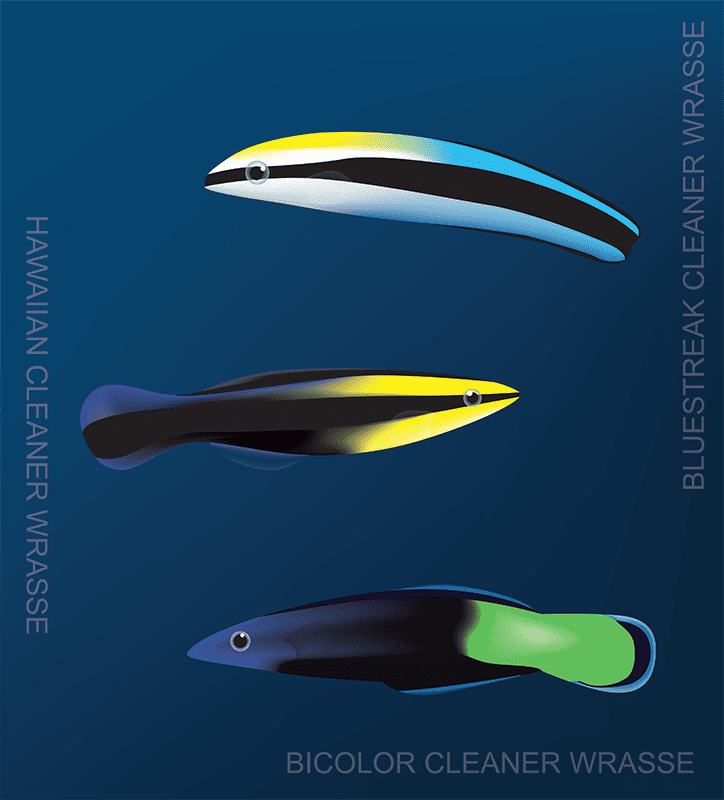
Habitat: Natural Geographic Distribution:
Labroides, the cleaner wrasses, are found in the tropical Indo Pacific. The popular Bluestreak Cleaner Wrasse, L. dimidiatusis, also know as the common Cleaner Wrasse has the most widely spread distribution ranging from Africa to the tropical Pacific. Cleaner wrasses inhabit coral rich areas of lagoons as well as tidal and seaward reefs.
Status:
These fish are not listed in the IUNC Red List, nor are they listed as endanger by CITES. However, the Bicolor Cleaner Wrasse L. bicolor has been declared protected by IUNC Sri Lanka due to naturally low populations. Also, in 1996 Hawaii banned collection of its endemic Hawaiian Cleaner Wrasse L. phthirophagus.
Description:
The cleaner wrasses are elongated slender fish with pointed snouts. They range between 3 1/2 inches (9 cm) for the smallest, the Redlip Cleaner Wrasse L. rubrolabiatus, and reach up to 5.9 inches (15 cm) for the largest, the Bicolor Cleaner Wrasse L. bicolor. A feature all five species have in common is a protractile mouth with protruding front “tweezer-like” teeth which allow them to reach and remove the parasites from their client’s bodies and mouths.
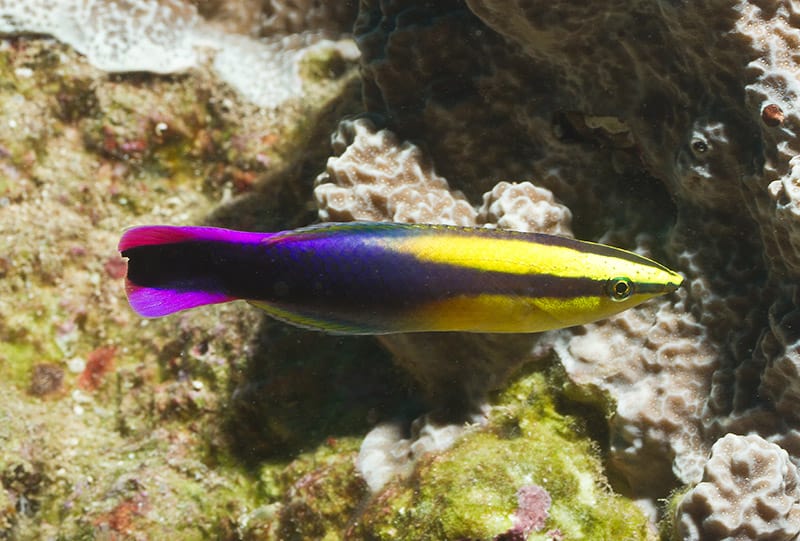
Foods:
As they are ‘obligatory‘ feeders, cleaner wrasses receive virtually all their nutrition through cleaning activities performed on other fish. They feed primarily on ectoparasites, dead tissues, mucus, and other debris found on just about every fish in the reef. They are also known to ‘cheat’ at times as well, biting their hosts and removing scales and live tissue.
Various research on the diet of these fish has produced disparate results. In one example it was found that the Bluestreak Cleaner Wrasse L. dimidiatusis from one locality primarily ate one thing while the same fish from another had a totally different composition in their diet. In her abstract Fish cleaning behavior in Noumea, New Caledonia, researcher Alexandra S. Grutter reports that the Bluestreak Cleaner Wrasse L. dimidiatusis from one locality primarily eats parasitic gnathiid isopods, while the same fish from another area eats none of these parasites. Grutter states, “These differences in diets may reflect the differences in numbers of parasites available…” and “It is surmised that this could be attributed to the locations, with the type and quantity of parasites available”.
Maintenance Difficulty:
Cleaner Wrasses have a poor history of sustainability in the marine aquarium. Tens of thousands have been brought into the hobby and out of those, only a sprinkling of reports describe any sort of success in keeping this fish alive.
The problems arise first from the stress of transport and relocation, which is then followed by their having a very specialized diet. They are obligate feeders, eating primarily parasites, mucus, scales, and debris from other fish. In the hobbyist’s marine aquarium this food is either not readily available, or not in sufficient quantities to sustain this obligate feeder. Once the parasites have been exhausted, the vast majority of these fish die of a slow starvation. Very few have been successfully encouraged to eat other foods.
For more information, see: Cleaner Wrasses in the Aquarium
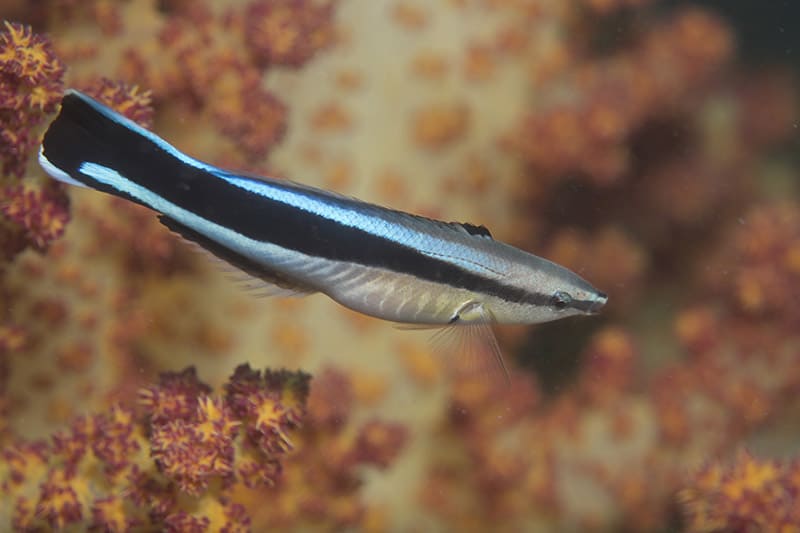
Social Behavior:
Cleaner wrasses are peaceful active fish living in a symbiotic relationship with many other ocean species. Males however are territorial, defending their area of the reef from other males and attracting smaller females. As obligate feeders, they develop a symbiotic relationship with other reef inhabitats. Because of this, they are visited by just about all the animals of the reef. In return for their services they are afforded a certain degree of protection from the natural predatory inclinations of larger fish, which instead become their hosts, also called their patrons or clients. Some research studies describe this as possibly being a ‘mutualistic‘ relationship, where the cleaners get fed and their hosts get massaged.
Behavior of cleaner wrasses and their clients:
Recognition of a cleaner by the host begins a series of behaviors. Studies indicate that host fish readily identify the cleaners by their color pattern, (rather than body size or shape). The Bluestreak Cleaners are recognized by the dark median horizontal stripe on their body.
For cleaning to commence there is an interactive display by both fish. The host will display various behaviors such as becoming trance-like, slowing its breathing, taking a vertical posture, opening its mouth and gill cover, and sometimes a partial color change. The cleaner will swim slowly forward performing a ‘dance’, where it uses the caudal fin to swing its hind body back and forth. Once the host has indicate its willingness to be cleaned the wrasse swims up and beats with its ventral fins on the host’s back, dorsal, and pelvic fins. The cleaner wrasse then commences with the cleaning, occasionally repeating the beating process. Occasionally a cleaner will ‘cheat’ by biting the host itself. The host will use twitching motions to tell the wrasse when to quit the cleaning activity.
A number of studies have been done to understand this unique behavior between cleaner and host, especially to determine why there is some variation in the display pattern, in the intensity of the cleaning pattern, and on the occasional biting behavior depending on the fish being cleaned.
The findings suggest that familiarity is one factor. Hosts that have a ‘good experience’, though they may not recognize the cleaner, will often return to the same territory for additional cleanings. Also, cleaner wrasses are sometimes eaten by unfamiliar predators. Another factor may be the availability of parasites, possibly biting hosts with fewer parasites.
Activities:
Though they are diurnal, sleeping at night, cleaner wrasses work incessantly during the day. They often set up a ‘cleaning station’, an area where the other fish come to be cleaned. There are usually one to three cleaner wrasses occupying a single cleaning station. These cleaning stations are often permanent. They service a vast and diverse number of species with one wrasse cleaning up to 2300 fish per day.
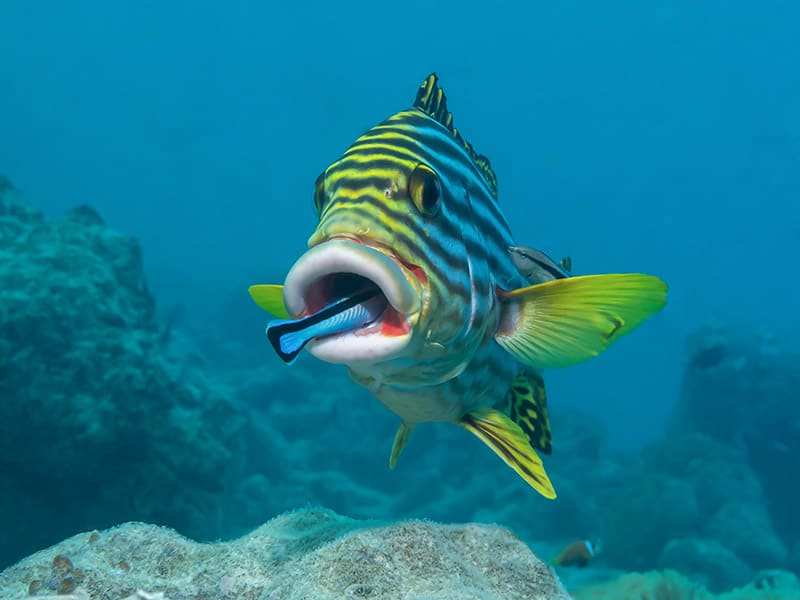
Breeding/Reproduction:
With little sexual dimorphism, the gender of most of these Labroides cannot be distinguished visually. Only the Bicolor Cleaner Wrasse L. bicolor can be identified by sex with the male having a bright spot on the back end of the body. On the female this spot dissolves into the line pattern.
One large dominant male patrols and defends a territory attracting several smaller females. The females will live in this territory, often setting up cleaning stations of their own, and spawn with the male. Should the male leave or die, it is believed that the dominant female changes sex and becomes the dominant male, patrolling the territory and spawning with the other females.
Cleaner wrasses are pelagic spawners. They spawn year round, primarily in the twilight hours. Females lay free-floating eggs in a water column where they are fertilized by the male. The eggs form planktonic larvae, moving freely with the ocean currents. There have been reports of successful spawnings of the Bluestreak Cleaner Wrasse L. dimidiatusis in marine aquariums, but nothing about successful rearing of the young.
Availability:
The Bluestreak Cleaner Wrasse or Common Cleaner Wrasse is the one cleaner that most often appears at retailers, it is also the least expensive. The others are much more rare as well as more costly.
Due to the extremely low success rate in keeping them alive, they are not recommend for the home marine aquarium. Be sure to carefully consider your impact on this species and on the ornamental fish industry as a whole before purchasing these fish.
Learn more before making a buying decision.
- See also: Cleaner Wrasses in the Aquarium.
Featured Image Credit: ANURAK PONGPATIMET, Shutterstock
